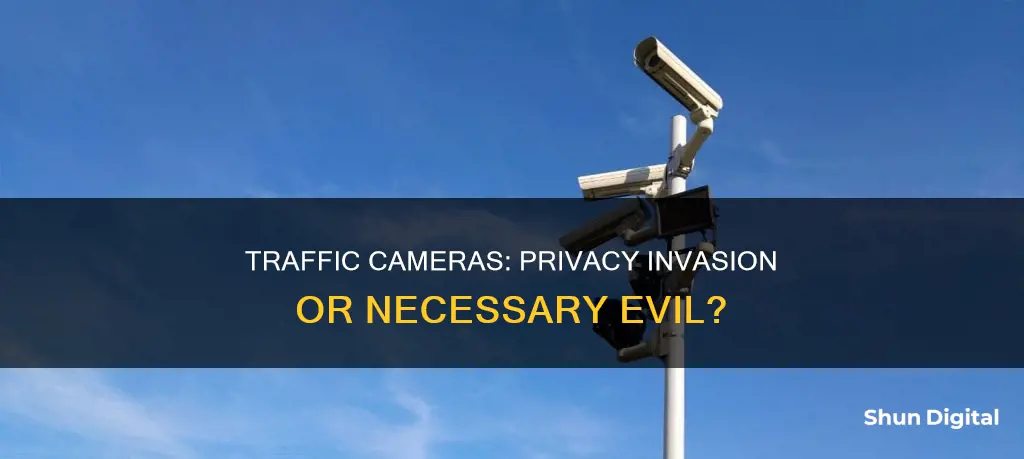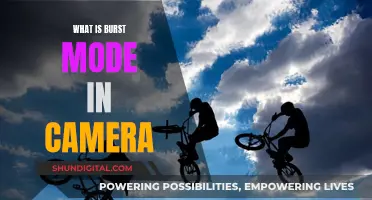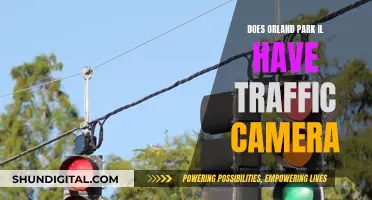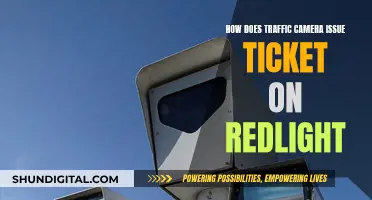
Traffic cameras have been the subject of debate regarding their potential invasion of privacy. These cameras, particularly red light cameras, are installed on highways to monitor and manage traffic flow. While their primary purpose is traffic control, some argue that they infringe on privacy. This debate centres around the question of whether the public benefit of these cameras justifies any potential invasion of privacy. For example, the ACLU has raised concerns about the use of red-light camera systems, citing issues of fairness and privacy. They argue that these systems should be halted or delayed until due process and privacy concerns are adequately addressed.
What You'll Learn
- Traffic cameras improve safety and save lives
- Cameras are only used to monitor traffic flow
- Cameras are placed in public spaces, where there is no expectation of privacy
- Drivers are aware of the cameras and their purpose
- The use of traffic cameras may set a dangerous precedent for government surveillance

Traffic cameras improve safety and save lives
The use of traffic cameras has sparked a debate about whether they are an invasion of privacy. However, the primary use of traffic cameras is to monitor and assist in traffic flow and improve road safety. Driving is a regulated activity, and traffic rules are in place to ensure the safety of all road users. Traffic cameras are an important tool in enforcing these rules and can help reduce the number of accidents and save lives.
Traffic cameras, such as red light cameras, are installed at intersections to monitor traffic flow and reduce the number of vehicles running red lights. While some argue that red light cameras do not improve public safety, evidence shows that they are effective at decreasing the number of vehicles running red lights, which can reduce the number of angle or "T-bone" accidents. In one study, red light cameras reduced the number of drivers running red lights by 67%.
Speed cameras are another type of traffic camera that aims to reduce vehicle speeds, particularly in high-risk areas such as school zones and residential neighbourhoods. By enforcing speed limits, speed cameras can help reduce the severity of collisions and the likelihood of injuries. Studies have shown that speed cameras are effective in reducing the number of road collisions and the number of people injured. For example, a study in Barcelona found that speed cameras reduced the number of road collisions by 27% and the number of people injured by the same amount.
In addition to improving road safety, traffic cameras can also help solve traffic issues and ensure public safety. For example, footage from traffic cameras can be used to identify vehicles involved in accidents or other incidents, locate missing persons, or track the movement of traffic to optimise signal timing and improve traffic flow.
While some may argue that traffic cameras invade privacy, it is important to note that driving is a regulated activity that takes place in public spaces. Road users are generally aware of the presence of traffic cameras and understand their purpose. As long as the cameras are used for their intended purpose of improving road safety and traffic flow, their use can be highly encouraged to create safer roads and save lives.
Exploring Camera Mode in Overlord: A Creative Perspective
You may want to see also

Cameras are only used to monitor traffic flow
Traffic cameras are often placed at complex intersections, congested roads, or areas with extreme weather conditions. They are typically mounted on poles, bridges, or other structures, such as street lights or traffic light poles. These cameras are strategically placed to provide a comprehensive view of traffic flow and conditions.
Traffic cameras are used to monitor and assist in managing traffic flow on highways and major roads. They are an essential part of cities' transportation and logistics departments, helping to improve traffic flow and road safety. The cameras provide real-time footage to a control centre, where traffic engineers or law enforcement personnel can monitor the traffic and take appropriate action in the event of accidents or disruptions.
One of the primary benefits of traffic cameras is their ability to reduce accidents and road collisions. According to a study, traffic monitoring cameras can lower accidents in accident-prone areas and reduce collisions by up to 15%. They also help in enforcing traffic laws, such as red-light violations and speeding, by capturing images or videos of vehicles breaking the rules.
Another advantage of traffic cameras is their contribution to enhanced data gathering for better traffic management and planning. Authorities can use the cameras to monitor traffic patterns and make informed decisions when developing new traffic strategies and road projects. This helps in reducing congestion and improving the efficiency of the road network.
In conclusion, traffic cameras play a crucial role in monitoring and managing traffic flow. Their use is justified by the significant benefits they bring to road safety, traffic management, and data gathering. While some may argue that they invade privacy, it is important to note that their primary purpose is to ensure the safety and efficiency of our road networks.
Rearview Cameras in Cop Cars: Standard or Optional?
You may want to see also

Cameras are placed in public spaces, where there is no expectation of privacy
The use of traffic cameras has been a long-standing debate, with some arguing that they are an invasion of privacy, while others claim they are necessary for security and traffic monitoring. These cameras are typically installed at highway intersections or busy roads to monitor and manage traffic flow. While some may argue that these cameras invade privacy, it is important to understand that they are placed in public spaces where there is no reasonable expectation of privacy.
When individuals purchase a vehicle and obtain a driving license, they agree to abide by the traffic rules and regulations, which include not running red lights. Traffic cameras, including red-light cameras, are a part of the traffic surveillance system and are programmed to capture images of vehicles that break these rules. The license plate of the vehicle, and in some cases, the image of the driver, is recorded to identify the offender. It is important to note that these cameras are not secretly monitoring the activities of individuals; their presence is known, and their purpose is to enforce traffic rules and ensure public safety.
In the case of Parveen Idris v. City of Chicago Illinois in 2009, the US Circuit Court of Appeal ruled that individuals do not have the right to avoid being seen by a camera on a public street when breaking traffic laws. This ruling reinforces the notion that traffic cameras are not an invasion of privacy. Additionally, laws in various countries support the use of surveillance in public spaces as long as individuals are aware of it. For example, Canada's Personal Information Protection and Electronic Documents Act allows surveillance in public places as long as those being monitored are informed about it.
The primary purpose of traffic cameras is to ensure road safety and enforce traffic rules. They are not intended to monitor the private activities of individuals within their vehicles. When an individual is driving, they are considered to be in a public space and are expected to follow the rules of the road. By capturing images of vehicles breaking the law, such as running a red light, these cameras help enforce traffic rules and hold offenders accountable. This use of cameras is not an invasion of privacy but rather a necessary tool to maintain public safety and order on the roads.
In conclusion, while the discussion about traffic cameras and privacy is ongoing, it is clear that placing cameras in public spaces, where there is no legitimate expectation of privacy, is justifiable. These cameras play a crucial role in traffic management and road safety, and their use is supported by legal rulings and privacy laws. As long as individuals are aware of the presence of these cameras and their purpose, there is no reasonable argument for considering them an invasion of privacy.
Troubleshooting Camera Focus Issues: What You Need to Know
You may want to see also

Drivers are aware of the cameras and their purpose
Traffic cameras are an everyday sight, and while many people have questioned whether they are an invasion of privacy, others argue that they are necessary for road safety. The use of traffic cameras has sparked a debate about whether they infringe on our right to privacy.
Drivers are generally aware of the presence of traffic cameras and their purpose. These cameras are typically placed at busy intersections or on highways to monitor and manage traffic flow. Red-light cameras, for example, are positioned to capture vehicles that run red lights or stop signs. Speed cameras are also common, and their primary purpose is to deter speeding and reduce accidents. These cameras can be fixed or mobile, with the latter being more challenging to detect.
The knowledge of these cameras serves as a deterrent for drivers, encouraging them to abide by traffic rules and regulations. The cameras are not hidden and are often placed in visible locations, such as mounted on poles or traffic signals. Their presence is intended to be noticed, acting as a constant reminder for drivers to follow the rules.
In addition to deterring traffic violations, traffic cameras also play a crucial role in ensuring public safety. For instance, they can capture images of vehicles involved in accidents, which can be crucial for accident investigation and insurance purposes. They also assist in monitoring and managing traffic flow, especially in congested areas, helping to improve the overall efficiency of the road network.
While some may argue that the use of traffic cameras is an invasion of privacy, it is important to note that driving is a regulated activity. When individuals obtain a driver's license and register their vehicles, they implicitly agree to abide by the rules of the road, which includes being monitored by traffic cameras. The primary purpose of these cameras is not to spy on drivers but to enhance road safety, reduce accidents, and facilitate the smooth flow of traffic.
In conclusion, while the presence of traffic cameras may be constantly felt by drivers, their awareness of these cameras and their purpose helps to maintain a balance between privacy and public safety. The use of traffic cameras is justifiable as long as they serve their intended purpose and do not infringe on the privacy of individuals beyond what is necessary for ensuring road safety.
Switching to Night Mode: Enhancing Low-Light Photography
You may want to see also

The use of traffic cameras may set a dangerous precedent for government surveillance
The use of traffic cameras has been a long-standing debate, with some arguing that they are a necessary tool for ensuring traffic safety and others claiming that they invade privacy. While the primary use of traffic cameras is to monitor and control traffic flow, there are concerns that their use may set a dangerous precedent for government surveillance and infringe on civil liberties.
One of the main arguments against traffic cameras is the potential for "mission creep" in their use. The American Civil Liberties Union (ACLU) has expressed concerns that the data collected by these cameras, which includes license plate numbers and vehicle owner information, could be used for purposes beyond traffic enforcement. In the past, similar systems have been used to capture the license plate numbers of law-abiding citizens crossing state borders, subjecting them to unnecessary inquiries. This type of expansion in the use of data collected by traffic cameras raises serious privacy concerns and highlights the potential for government overreach.
The use of traffic cameras also raises questions about due process and fairness. In the case of red-light camera systems, for example, the tickets are often sent to the owner of the vehicle, regardless of who was driving at the time. This shifts the burden of proof onto the vehicle owner to prove their innocence, which is a clear violation of the fundamental American legal principle of "innocent until proven guilty." Additionally, there are concerns about the financial incentives surrounding these cameras, with contractors receiving a portion of ticket revenue, leading to a potential conflict of interest and further eroding public trust in the system.
The implications of the expanding relationship between tech corporations and government agencies in the context of surveillance cannot be overstated. As seen in the case of San Francisco's new camera ordinance, which allows police to access live footage from privately owned internet cameras, there is a growing trend of governments leveraging private surveillance infrastructure for their own purposes. While this may be justified in the name of public safety and crime prevention, it sets a precedent for increased government access to personal data and surveillance capabilities, which could be misused or abused in the future.
In conclusion, while the use of traffic cameras may have some benefits in terms of traffic management and safety, there are significant risks associated with their implementation. The potential for government overreach, privacy invasions, and due process violations are all serious concerns that must be carefully considered. As the relationship between technology and surveillance continues to evolve, it is crucial to establish clear boundaries and safeguards to protect the civil liberties of citizens and prevent any dangerous precedents from being set.
Updating Adobe Camera Raw: A Simple Guide
You may want to see also
Frequently asked questions
Traffic cameras are not considered an invasion of privacy as long as individuals are aware of their existence and their primary purpose is to control traffic flow and ensure safety.
Traffic cameras, particularly red-light cameras, are installed on highways and major roads to monitor and manage traffic flow. They help enforce traffic rules, such as running a red light or stopping at a stop sign.
Traffic cameras capture images of vehicles and license plates, and sometimes the driver, when traffic rules are violated. While some argue that this is an invasion of privacy, others claim that driving is a regulated activity, and individuals are aware of the cameras' presence.
There are concerns about the potential for "mission creep," where data collected by traffic cameras could be used for purposes beyond traffic enforcement. Additionally, there are fairness issues, such as tickets being sent to vehicle owners who may not have been driving, and the potential for contractors to "game" the system for increased revenue.







